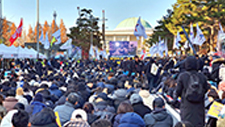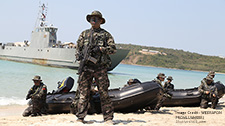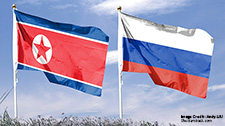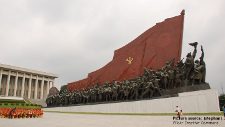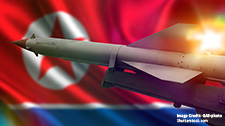Not a Sovereignty Issue: Understanding the Transition of Military Operational Control between the United States and South Korea
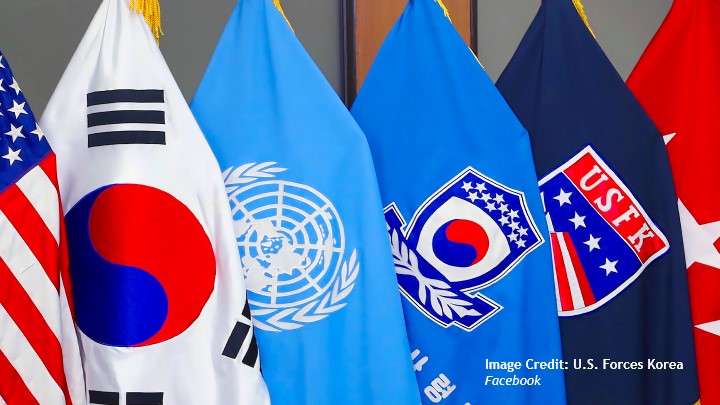
ISDP
Abstract
The transition of operational control (OPCON) is of significant importance for the future development of the alliance of the Republic of Korea and the United States (KORUS). However, it will likely prove challenging as it is misunderstood by South Korean public opinion and political leaders as an issue of sovereignty. If this misconception is not addressed – there is an urgent need to inform not only the South Korean public but also political leaders and opinion makers – the alliance of South Korea and the United States risks being harmed, with potentially adverse effects on security on the Korean Peninsula. But if successful, the OPCON transition will manifest the maturation of the KORUS alliance, establishing a much more equal partnership.
Introduction
This Backgrounder aims to provide a brief historical background to what OPCON is, when and why it was established, as well as describe its goals. The report will subsequently move towards more recent developments, focusing on U.S.-ROK joint discussions on the transition of the military command and what hurdles need to be overcome in order to achieve it. To conclude, this Backgrounder will present common misconceptions of OPCON and possible implications regarding the future transition.
Historical Background
In 2007, then-President of the Republic of Korea Roh Moo Hyun requested the United States return wartime OPCON as a means of regaining South Korean national sovereignty and pride by “overcoming the nation’s psychological dependence on the United States”. The Republic of Korea had gained Armistice Operational Command of its forces, which is more commonly referred to as peacetime OPCON, in 1994. This transfer, which made the command structure of the U.S.-South Korea alliance more co-equal, was above all a diplomatic gesture by the United States. Under Armistice conditions, military training, maintenance, and equipping procedures are under Seoul’s control. Only when war is declared, and only with the approval of the respective presidents of South Korea and the United States, is OPCON of designated Armed Forces of the Republic of Korea (ROKA) units to be transferred back to the Combined Forces
Command (CFC.)
OPCON is the “authoritative direction over all aspects of military operations, joint training, and logistics necessary to accomplish the missions assigned to the command” but “does not, in and of itself, include authoritative direction for logistics or matters of administration, discipline, internal organization, or unit training”. Operational control differs from combatant command (COCOM), which is the “exercise of authority and direction by a commander over assigned and attached forces to accomplish the mission”, established by the president of the United States. OPCON is a subset of command authority or “the authority to perform those functions of command over subordinate forces […] necessary to accomplish the mission [emphasis added]”. Therefore, the nation, in this case the Republic of Korea, that transfers operational control of its own army to the U.S., does not forfeit command authority over its military operations and administration nor its control over the whole chain of command.
The U.S. has had operational control of the armed forces of South Korea since 1954. In November 1954, a year after the Korean Armistice Agreement was signed, it was agreed that the ROKA would remain “under the operational control of the United Nations Command while that command has responsibilities for the defense of the Republic of Korea unless after consultation it is agreed that our mutual and individual interest would best be served by a change.”
This was a precondition for the ratification of the U.S.-ROK Mutual Defense Treaty. In November 1978, after two decades of criticisms and questioning in South Korea and the removal of all non-U.S. combat troops from the ROK, the U.S.-ROK Combined Forces Command (CFC) was established as the entity responsible for the defense of the ROK, while the United Nations Command (UNC) was maintained as a supervisory entity of the Armistice Agreement. The double hat of Commander General of CFC and the UNC was and is still worn by the same 4-star U.S. Army General appointed by Washington
every three years.
The CFC introduced a more cooperative and equal system of OPCON over the ROKA. This unique bi-national command system is structured as a bi-manned chain of command: “If the chief of a staff section is Korean, the deputy is American and vice versa”, beginning at the very top where the CGCFC is a four-star U.S. Army General and his deputy a four-star ROKA General. The CGCFC, in cooperation with his Deputy, answer to both U.S. and ROK National Command Military Authorities through the annual Security Consultative Meeting (SCM) and Military Committee Meeting (MCM) – see Figure 3 for a graphic representation of the ROK-U.S. combined command structure.
The 1994 transfer of peacetime OPCON to the ROK was supposed to be followed by talks on the transfer of wartime OPCON, scheduled to begin in 1996. These talks were
unfortunately postponed due to the outbreak of the Democratic People’s Republic of Korea (DPRK) nuclear crisis in 1993. OPCON transition talks did not resume until 2005. It was not until October 2006 that U.S. Secretary of Defense Donald Rumsfeld and ROK Minister of National Defense Yoon Kwang Ung agreed that wartime OPCON of ROK forces under a U.S.-led command would be handed over sometime between October 2009 and March 2012.
In 2010, U.S. President Barack Obama and South Korean President Lee Myung Bak agreed to delay OPCON transition to December 2015. However, as North Korea stepped up its nuclear program, OPCON transition was postponed indefinitely in 2013. Instead, in 2014, the two allies set conditions that needed to be fulfilled for the transition. Both sides had come to appreciate that the way the OPCON transition was implemented mattered more than when it occurred. The adoption of a so called Conditions-based OPCON transition plan (COTP) meant that OPCON transition would take place only when “critical ROK and Alliance military capabilities were secured, and the security environment on the Korean Peninsula and the region was conducive to a stable OPCON
transition”.
Notably, the latest development regarding the issue of OPCON transition surfaced after U.S. Secretary of State Antony Blinken and Defense Secretary Lloyd Austin III’s trip to South Korea on March 17, 2021. During a meeting, both Defense Secretary Austin III and South Korean Minister of National Defense Suh Wook underscored the almost unparalleled importance of the U.S.-ROK alliance, due impart to the growing and dire challenges posed by North Korea and China.
In the subsequent 2+2 meeting between Austin III, Blinken, Wook, and ROK Foreign Minister Chung Eui-yong, the four addressed the issue of OPCON and the necessity of full joint ROK-U.S. readiness in the face of the aforementioned challenges. Both the ministers and secretaries recognized the U.S. and South Korea’s impressive progress in their “fight-tonight” readiness and their preparations to successfully transition to a ROK-commanded CFC.
All four identified the main focus not as the transition itself, but the joint U.S.-ROK capability to defend the alliance and the South in case of a contingency. In other words, as Pentagon spokesperson John Supple stated, the commitment to a specific timeline would only increase the risks for the alliance and U.S. and Korean personnel. Therefore, the transition is “based on security conditions rather than political expediency”.
Given the fact that OPCON will remain condition-based, “Washington’s stance on the issue will not change even if it is reviewed again” in the future. Seoul has yet to fully meet the mutually-agreed upon conditions, so it appears the transition will not take place during the Moon administration or any other time soon.
Current Misconceptions Surrounding the Issue of OPCON Transition
Today OPCON transition is of utmost importance given that it concerns not only South Korea, but also the U.S. military apparatus away from American soil. The U.S. presence in South Korea is extensive, and is the third highest concentration of forward-deployed personnel and equipment after only Japan and Germany. In South Korea, OPCON transition is subject to much confusion and misconceptions, meaning that conspiracy theories tend to gain traction not only among the public but also at the elite level. Therefore, given the issue’s wide ramifications, clarification of misconceptions and misrepresentations is necessary. One example is the idea that the U.S. wants to maintain control of the CFC by using the UNC. According to another theory, Washington never had any intention of completing the transition; therefore, the U.S. is advancing impossible conditions to ensure that the transition does not occur.
There is a perception in South Korea – among the public and pundits – that President Moon Jae In aspires to achieve OPCON transition before his term ends in 2022. Yet neither the president himself nor any current representative of his administration has ever stated that OPCON must be regained before 2022, even though the government’s official policy was and still is to do everything possible to reach this objective within Moon’s term. This misconception can be traced back to Moon’s first Minister of Defense, Song Young Moo, who acted as if the administration’s goal was for OPCON to take place within Moon’s term, and many have assumed that this view is shared by the wider administration, which is not the case.
Fundamentally, South Korean attitudes to the issue are conditioned by nationalist sensitivity; ultimately, as former President Roh Moo Hyun’s statement in 2007 (quoted above) bore witness, the transition of wartime OPCON to South Korea is perceived as a full recovery of South Korean national sovereignty. Indeed, it was pointed out that “control of a country’s military is inherently supposed to rest with the sovereign nation’s authorities”. Nevertheless, OPCON transition is technically not an issue of sovereignty, even though it is perhaps understandable that it is perceived as such in South Korea. However, bearing in mind the distinction between COCOM and
OPCON (see above), it should be clear that the U.S. government does not wield authoritative command over South Korea’s armed forces; hence it does not infringe on South Korea’s sovereignty.
The transition of wartime OPCON of designated ROK forces to the CGCFC is subject to the joint approval of the presidents of South Korea and the United States. The fact that both sides have to decide to provide troops to the KORUS CFC is further proof that OPCON transition is indeed not a sovereignty issue.
Since the CGCFC reports directly to both presidents — American and South Korean —
formally, the nationality of the commander is arguably of no consequence; he or she is expected to report to both presidents through the respective Ministers and Secretaries of Defense, the JCSs.
The ROK-U.S. CFC has OPCON of both ROKA and USFK, and the CGCFC has worked equally for both countries since 1978. The fact that the current CGCFC and previous ones were U.S. Army personnel does not mean the CGCFC has authoritative command over the ROKA. COCOM of the USFK falls under the U.S. president and COCOM of the ROK falls under the South Korean president. On the face of it, the imbalance that existed earlier within KORUS, the alliance of South Korea and the United States, has been addressed, with the former becoming an equal partner. Seemingly, this is confirmed by the fact that the U.S. will accept a South Korean general as CGCFC, once OPCON transition occurs. It has been argued that this sends a powerful message of trust toward Seoul as an ally. However, it could be argued that the fundamental imbalance remains unaltered as the degree of “equality” that South Korea, the junior partner, is granted depends on the “acceptance” of the United States, the major partner.
There is also a general perception in South Korea that the U.S. is unwilling to relinquish
OPCON and that the UNC must become, once again, the supreme headquarters for the
ROKA and USFK.
In fact, the South Korean public tends to misconstrue the role of the UNC, which is wrongly viewed as an obstacle to the development of inter-Korean relations. The UNC is currently the supervisory entity, together with the Neutral Nations Supervisory Commission (NNSC), that oversees the Armistice. Furthermore, there is a general confusion in South Korea regarding the roles of the UNC and the CFC, respectively, in case of an outbreak of war on the peninsula. There also seems to be a lack of clarity, due again to the lack of understanding of what OPCON is and how it works, on the role of both institutions in either conventional or nuclear war on the peninsula. In such a scenario, the UNC will serve as the headquarters welcoming the forces from those states that come to the defense of South Korea.
Another major complication is that the South Korean public and elite fail to distinguish
between peacetime and wartime OPCON. As a term used in relation to OPCON, “peacetime” is, in fact, less valid in the sense that the two Koreas are still legally at war. The term peacetime OPCON is thus formally invalid, and Armistice OPCON is more appropriate.
As stated earlier in this report, armistice – or peacetime – OPCON was transferred to Seoul in 1994 in anticipation of a full-fledged transition. In fact, for the U.S., this represented a major concession; there is a lack of understanding on the South Korean side about the risk that the U.S. took by handing over peacetime OPCON. This was illustrated when North Korea sunk the South Korean frigate Cheonan and shelled the island of Yeonpyeong. As a result, Washington risked getting involved in an armed conflict after having transferred Armistice OPCON. These events illustrate that the landscape of relations, signaling, and actions between nations are particularly murky under armistice conditions, thereby serving as a reminder that it is the U.S. and South Korean presidents who jointly judge what provocations are deemed to have crossed the threshold for war.
Some in South Korea anticipate and fear that the United States will withdraw its support of South Korea after OPCON takes place and that the bi-national, bi-manned, well-coordinated chain of command will be affected. One misunderstanding is related to the practical reality of CFC. When OPCON transition takes place, the CFC will not become void; it will still remain in charge of the defense of South Korea and responsible
for ensuring security on the Korean Peninsula. Additionally, OPCON transition does not imply any dissolution of the CFC into two separate command structures: a KORUS war-fighting command under the Joint Chiefs of Staff (JCS) and a regression back to the initial command relationship between the U.S. and the ROK, with two different commands, one subordinated to the other. The appointment of a South Korean four-star Army General as the new CGCFC will not alter the current chain of command or the current command relationship between USFK and ROKA. When a ROK General is appointed, CGCFC, in the same way as all previous American CGCFCs before, will work for both presidents through the Military Committee (MC), the entity that provides strategic guidance and oversight for the KORUS combined forces.
Nonetheless, the transition will likely prove challenging and complicated as it is perceived as a sovereignty issue by the South Korean public in general and the political elite and media in particular. Moreover, OPCON may become an issue of sovereignty in the U.S. Washington has a history of never relinquishing command of its forces to a
foreign nation, the so-called Pershing Rule. This could well become a preeminent issue
within the American general public, the media, and the political sphere if no distinction
between COCOM and OPCON is made and if the notion that the U.S. has surrendered the command of its troops to South Korea were to gain traction. In South Korea, within the cohorts of those opposing the transition, there is a general misconception that when OPCON transition occurs, the peninsula’s security will be affected negatively. In fact, those opposed to the OPCON transition are prone to believe that, when the transition takes place, the ROKA’s preparedness and capability will be worse off due to a weakening of the alliance between Seoul and Washington, which is supposedly going to pull USFK personnel out of South Korea. Currently, there is no discussion of U.S. troop reduction and withdrawal from the peninsula. Nonetheless, in general, throughout the history of the KORUS alliance, there have been periodic troop reductions.
The CFC periodically assesses its requirements: the amount and the type of forces necessary for both the presence on the Korean Peninsula and in the region, as well as the amount and type of troops necessary for deployment directly from the U.S. to support deterrence regionally and ensure South Korea’s security. However, this is by
definition an ever-changing calculus. The U.S. Congress, as of 2020, has placed constraints on the reduction of U.S. troops below the current level of 28,500.20 In the latest National Defense Authorization Act (NDAA), Congress requires certification and assurance from the Secretary of Defense that proposed troop reductions will have no detrimental impact on American national security or the security of South Korea and Japan. Concomitantly, the Secretary of Defense is required to consult with and obtain carte blanche from the United States’ Far Eastern allies – Japan and South Korea – regarding any withdrawal. There is a general understanding that the COTP’s three basic conditions are intangible, that mission essential tasks are not clear, and the three-phase preparation for wartime OPCON transition – Initial Operational Capability (IOC), Full Operational Capability (FOC), and Full Mission Capability (FMC) – agreed upon in August 2019, are not practical.
Given the general misconceptions and even conspiracy theories about these preconditions to OPCON, there needs to be a higher degree of focus on more practical goals. Focusing on more feasible goals would improve the general public’s perception and reaction to OPCON. Aiming for more realistic training for the South Korean military and its reserve forces, which the ROK could do without external assistance, and a general revamp, reorganization, and modernization of South Korean mobilization plans would also help improve the country’s security posture. Despite these shortcomings, the ROK can expedite and fulfill COTP, reach the three-phase preparation conditions, and fulfill the Defense Reform 2.0. Despite ROK’s ability in
practical terms to achieve COTP, there seems to be a lack of political will to succeed and
work hard toward these objectives.
The political leadership of South Korea needs to state what sacrifices OPCON transition calls for, such as raising taxes to meet the increased military spending required under full mission capability, while making it clear to the public that it is their objective to achieve. Also, South Korea will need to address the possible economic risk that a decision to opt out of its current hedging strategy might entail if China were to retaliate in response. This, in turn, would discredit the claim that the obstacle to OPCON transition is the supposed opposition of the United States.
Conclusion and Some Suggestions
OPCON transition is one of the most misunderstood issues of the U.S.-South Korea alliance. It is mistakenly seen as an issue of national sovereignty by South Korea.
Fundamentally, South Korean attitudes are conditioned by nationalist sensitivity;
ultimately, the transition of wartime OPCON to South Korea is perceived as a recovery
of full national sovereignty. There is an urgent need to inform not only the South
Korean public but also political leaders and opinion-makers in the media about the true
significance and security implications of the issue. However, for this to happen, both the governments in Seoul and Washington have to decide this effort is worth undertaking.
This endeavor of demystification – requiring a joint effort from both South Korea and the U.S. – must also be extended to the question of the UNC, its history, and its role on the peninsula, about which there is general ignorance in South Korean society. This is
so because the Commander General of both CFC and UNC has always been American,
which fuels the conspiracy theories referred to above – for instance, that the U.S. wants
to maintain control of the CFC by using the UNC – which has a negative impact on
OPCON. It is also necessary to identify the impact of OPCON transition on the UNC
and inform those segments of South Korean society that have misunderstood the role of
the UNC. Additionally, fake news about the UNC must be countered. While South Korean politicians, national security experts, and the military need to focus on OPCON transition, they would also do well to take a broader view and consider what the future of the CFC, the UNC, and the KORUS alliance in general will look like.
If OPCON transition is handled well, the KORUS alliance will be more robust and
reliable, enhancing the security of both the Korean Peninsula and Northeast Asia. It will
most definitely not be an easy feat to achieve, given the preconditions and the amount of effort that will be required at every level in both countries – civil society, political, military, and media spheres. From an American perspective, the country’s troop presence and its alliance with both Japan and South Korea might be enough to fend off an attack from North Korea, however, more is required. As far as the ROK Army is concerned, it does not have enough strength to conduct a prolonged conflict if it were to widen into a confrontation with China, not an unlikely prospect. In Seoul, KORUS is understood as a means to defend the South from any attack from the North. In Washington, meanwhile, KORUS is part of a larger framework. Therefore, there is a gap in understanding the scope and the goals of the alliance.
It is crucial that a South Korean General commands KORUS CFC. Whether there is war, regime collapse, instability, or any contingency that requires military operations to take place inside North Korea, it will be critical that a ROK general is in charge of operations under the CFC banner. The presence of a ROK CG in command of CFC will contribute to the dissipation of perceptions in South Korean society of the United States as an
occupying power on the Korean Peninsula.
Yet, it should not be disregarded that although the transition of the CGCFC hat from a U.S. Army General to a South Korean General will be beneficial in this respect, it can also complicate the chain of command structure. It is crucial to ensure continued, smooth coordination between CFC and UNC – given that the CG hat of both, together with the CGUSFK hat, is currently worn by the same individual. A South Korean general can be CGCFC but cannot, under Resolution 84, be appointed CGUNC. UNC command and appointment of its CGs falls under Washington’s decision. Indeed, the U.S. will retain control of USFK and UNC under the same CG, who will have to coordinate with
a future and new South Korean CGCFC. This change will put a certain degree of stress on CFC-UNC-USFK coordination but may raise the profile and awareness about a plethora of issues connected to the Korean Peninsula in general: the UNC, the CFC, international presence, and political interest towards the ROK and the DPRK among others.
OPCON transition is crucially important, insofar as it is successful, it could lead to a developed KORUS alliance, and thus a truly equal partnership between South Korea and the United States.
Related Publications
-
Martial Law and Political Polarization: What’s in Store for South Korea?
Abstract On December 3, South Korean President Yoon Suk-yeol declared emergency martial law, shocking both the country and the rest of the world. However, the martial law was only in […]
-
Unraveling of a martial law attempt: South Korea’s democratic moment
South Korea, once known as the “Land of the Morning Calm” and the Hermit Kingdom, has a complex modern history marked by ideological tensions and political challenges. Since the establishment […]
-
Russian and DPRK Military Cooperation in Ukraine – A Win-Win?
In early August 2024, Ukraine launched a significant offensive in the Kursk region in Western Russia which may have prompted the activation of the DPRK-Russia Strategic Partnership Agreement and triggered […]
-
Kamala Harris on North Korea: Change or Continuation?
Despite many efforts and different strategies, both previous and current U.S. administrations have been unsuccessful in preventing the Democratic People’s Republic of Korea (DPRK) from developing its nuclear and missile […]
-
Kamala Harris and North Korea: Between Continuity, Pragmatism, and Strategic Realignment
A possible future Harris administration is likely to continue the Biden administration’s approach to North Korea, focusing on sanctions and diplomatic pressure. This strategy may be shaped by broader geopolitical […]
